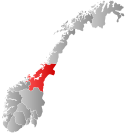Stod Municipality
Stod herad | |
|---|---|
 View of the Finstad farm area in Stod | |
 Trøndelag within Norway | |
 Stod within Trøndelag | |
| Coordinates: 64°04′16″N 11°40′05″E / 64.07111°N 11.66806°E | |
| Country | Norway |
| County | Trøndelag |
| District | Innherred |
| Established | 1 Jan 1838 |
| • Created as | Formannskapsdistrikt |
| Disestablished | 1 Jan 1964 |
| • Succeeded by | Steinkjer Municipality |
| Administrative centre | Binde |
| Area (upon dissolution) | |
• Total | 275 km2 (106 sq mi) |
| Population (1964) | |
• Total | 1,268 |
| • Density | 4.6/km2 (12/sq mi) |
| Demonym | Stodbygg[1] |
| Time zone | UTC+01:00 (CET) |
| • Summer (DST) | UTC+02:00 (CEST) |
| ISO 3166 code | NO-1734[2] |
Stod is a former municipality in the old Nord-Trøndelag county in Norway. The 275-square-kilometre (106 sq mi) municipality existed from 1838 until 1964. It originally encompassed the northern part of what is now the municipality of Steinkjer, stretching from the town of Steinkjer to the northeast, along the lake Snåsavatnet, to the municipal border with Snåsa. Over time, however, the municipality was reduced in size to just a fraction of its original size, leaving just the area between the Snåsavatnet in the north to the Ogndal valley in the south. The administrative centre of the municipality was the village of Binde. The main church for Stod was For Church, located just south of the administrative center. The local sports team is Stod IL.[3]

Stod is best known for rock carvings in the Bølareinen field that are approximately 6000 years old. The carvings are of animals and humans. There are several other prehistoric sites, including two stone circles, one on the Nordgård farm and one at the rectory, both of which are partially destroyed.
Traditionally, agriculture and forestry were the major industries in Stod, but construction of the Nordlandsbanen railway line brought with it new jobs and a dairy. Today most residents of Stod work in the town of Steinkjer.[4]
- ^ "Navn på steder og personer: Innbyggjarnamn" (in Norwegian). Språkrådet.
- ^ Bolstad, Erik; Thorsnæs, Geir, eds. (26 January 2023). "Kommunenummer". Store norske leksikon (in Norwegian). Kunnskapsforlaget.
- ^ Rosvold, Knut A., ed. (5 February 2018). "Stod". Store norske leksikon (in Norwegian). Kunnskapsforlaget. Retrieved 8 April 2018.
- ^ Steinkjerleksikonet. "Stod kommune" (in Norwegian). Retrieved 16 July 2011.